Welch Allyn QuietTrak User manual

Manuals
Service Manual
Arden, North Carolina USA |
||
|
|
RY |
|
TE |
|
R |
|
|
A |
|
|
S |
Y |
S / |
|
|
|
|
|
|
|
D I |
|
|
|
A |
mmHg |
|
|
|
♥
Operator’s Manual
QuietTrak Serial Number: __________________________________
Date of Purchase: _________________________________________
Dealer Name: ____________________________________________
Telephone: ___________________________________________
Dealer Representative Name: _______________________________
Telephone: ___________________________________________
Welch Allyn/Tycos
Sales Representative: __________________________________
WARNING
This device not intended for use with a defibrillator, for neonatal use, or with any intravascular fluid system.
The CE mark on this product indicates it has been tested to and conforms with the provisions noted within the 93/42/EEC Medical Device Directive.

 0050
0050
European Regulatory Manager
Medical Division
Welch Allyn Ltd.
Navan, Co. Meath
Republic of Ireland
Welch Allyn/Tycos QuietTrak™ ABPM Operator’s Manual
Copyright 1993 Welch Allyn/Tycos Instruments, Inc. All rights reserved.
Patent No. 5,556,073

Contents
i About the Manual
iii Quick Guide to Hookup & Operation
1 Product & Report Features
1-2 Product Features
1-4 Specifications
1-6 The Report
2 Getting Started
2-2 Unpacking Checklist
2-4 Features at a Glance
2-7 Battery Requirements
2-8 Loading the Batteries
2-9 The Power-On Self-Test
2-10 Setting Date & Time
3 Choosing Program Options
3-2 Overview of Program Options
3-7 Basic Parameters — Step-By-Step Programming
3-15 Advanced Parameters — Step-by-Step Programming
3-19 Special Parameters — Step-by-Step Programming
3-23 Flow Charts for Parameter Programming
3-27 Office Record of Program Selections
4 Patient Hookup
4-2 Before the Patient Arrives
4-4 Preparing the ABP Monitor for Use
4-12 Sizing the Cuff to the Patient
4-14 Positioning the Cuff & Microphone
4-21 Taking the Office Runs
4-24 Verifying the Setup
4-26 Beginning the Regular Runs
4-27 Positioning the Pouch & Tubing
4-29 Instructing the Patient
5 When the Patient Returns
5-2 Disconnecting the ABP Monitor
5-3 Ending the ABP Monitoring Session
5-5 Reviewing the Data
5-7 Printing the Data
6 Clinical Recommendations
6-2 The Clinical Usefulness of Ambulatory Blood Pressure Monitoring
6-5 Application of ABPM to Your Practice
6-6 Patient Benefits of ABPM
7 Troubleshooting Guide
7-3 Error Messages (in alphabetical order)
7-5 Error Codes
7-7 Special Messages
7-8 Trouble Chart
8 Service, Supplies & Maintenance
8-2 Calibration Check
8-6 Maintenance & Cleaning
8-7 Warranty
8-8 Welch Allyn/Tycos Service Centers
8-9 Ordering Supplies & Accessories

About the Manual
This Operator’s Manual is designed to help you get the most out of your Tycos QuietTrak Ambulatory Blood Pressure Monitor. The manual has eight tabbed sections. The first page of each section outlines the contents so you can readily find what you need.
The first section, Product & Report Features, introduces you to the product and its capabilities. The next four sections (Getting Started, Choosing Program Options, Patient Hookup and When the Patient Returns) take you step-by-step through the functional operation of the ABP monitor in a logical sequence.
The last three sections, Clinical Recommendations, Troubleshooting Guide, and Service, Supplies & Maintenance, are informative resources which offer troubleshooting or special help as needed.
Recommendations for First-Time Users.
First-time users may want to begin learning about the Tycos QuietTrak ABPM by reading Product & Report Features. Or, for hands-on instruction to begin using the ABP monitor, turn to Getting Started. Next, familiarize yourself with Patient Hookup and When the Patient Returns.
Recommendations for
More Experienced Users.
For day-to-day operation, experienced operators can refer to the convenient Quick Guide to Hookup & Operation found on page iii.
For those interested in learning and customizing the ABP monitor’s optional features, Choosing Program Options guides you step- by-step in selecting the options you want.
This manual is also available in German, French, Spanish, and Italian. Contact your local Welch Allyn/Tycos Service Center for more information.
i

Style Features of the Manual
The manual is written in a logical sequence so that you can follow the events page-by-page and step-by-step. Each step is identified with a bold subheading in the left margin...
(example of style features)
Setting the Date (example of a subheading)
...and detailed instructions follow. With this format, you can rapidly skim over the parts you are familiar with and advance to the steps you need.
The instructions are enhanced with illustrations and graphics. Each instructional step is paired with a graphic representation of the corresponding ABP monitor display:
Yes |
No |
Next (example of a graphic) |
Set Date ? |
|
|
When the Set Date ? message appears, you are ready. Press Yes in response to the Set Date ? message. A new message will appear.
Additional comments are placed in shaded boxes to draw attention to them. They are also identified by the following symbols appearing in the margin:
!
*
?
Important note or caution
Helpful hints, notes or suggestions
Conditional statements
(example of a box frame)
!The boxed messages are important. Be sure to read them.
At the conclusion of each section, there are suggestions to guide you where to go next. So, regardless of where you choose to begin, the manual conveniently directs you to related topics.
Suggestion for First-Time Users:
•Learn more about the ABP monitor in Product & Report Features, Section 1, and
•Practice using the monitor in Getting Started, Section 2.
ii

Quick Guide to Hookup & Operation
The Quick Guide briefly outlines the steps needed to operate the Tycos QuietTrak ABPM and hook up the patient. The complete instructions are found in Sections 2, 3, and 4.
1. Select appropriate cuff size.
Carefully attach microphone over brachial artery 1 to 1.5 inches (2.5 to 3.8 cm) above elbow (use microphone anchoring pad). Be sure the labeled side of the microphone faces away from the arm.
2. Wrap cuff on patient’s arm and secure it with cuff anchoring pad.
AAA
AAA
3.Load four new AAA batteries.
AAA
Wait while ambulatory blood pressure monitor completes Self-Test.
AAA
iii

4.Get ready to set patient ID :
If Set Patient ID ? is not shown, respond to displays as follows:
Review Data ? No.
Print Data ? No.
Erase Data ? Yes.
Are You Sure ? Yes.
Yes |
No |
Next |
|
Set Patient ID ? |
|
||
Up |
Down |
Next |
|
071 |
Ê |
|
|
Set parameters, including :
5. Set the patient’s ID.
Answer Yes.
(Use Up or Down to rotate to the number, then Next to proceed to each space, and finally to proceed to next display.)
•Number of periods,
•Beginning time of each period, and measurement interval
•Maximum pressure,
•Display On or Off,
•Patient Activation Button On or Off
6. Connect ABP monitor to patient’s cuff assembly.
Take three or more office runs.
Begin Regular Runs.
Insert ABP monitor into pouch and position pouch on patient with belt or shoulder strap.
iv
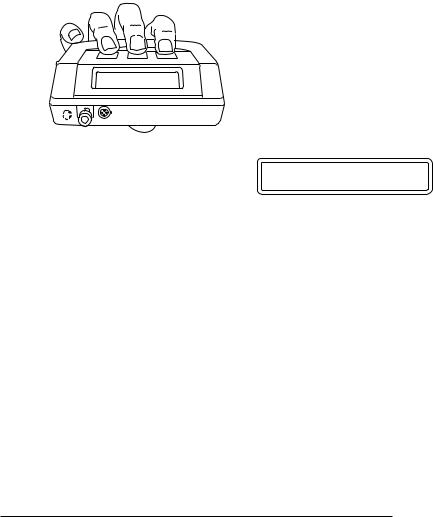
7. Instruct patient…
concerning Patient Diary, Patient Activation Button, how to cancel readings, and to remain still during readings.
8.When patient returns
1.Remove cuff assembly and ABP monitor from patient.
2.Review diary entries with patient.
3. End ABP monitoring session by pressing all three buttons simultaneously.
4. Press Yes to begin |
Yes |
No |
Next |
|
reviewing data on the |
||||
Review Data ? |
|
|||
ABP monitor’s display.
5.Press Next to move to
Print Data ? screen.
6.Connect ABP monitor to printer and print data.
v

Product & Report Features |
1 |
|
The features and specifications of the Tycos QuietTrak Ambulatory Blood Pressure Monitor explained in this section will help you understand its capabilities. You may not use every feature offered, but knowing what’s available will help you optimize your monitoring procedures.
At the end of this section, the pages of the report are illustrated and explained so that you can get the most out of the ambulatory blood pressure data.
Page |
Topic |
1-2 |
Product Features |
1-4 |
Specifications |
1-6 |
The Report |
1-1

Product Features
Accurate Measurement
What makes the Tycos QuietTrak Ambulatory Blood Pressure Monitor accurate? Developed and tested by a leader in the blood pressure industry, the Tycos QuietTrak ABPM sets unbeatable standards.
•Auscultatory method — the gold standard in the physician’s office.
•Tested scientifically by Tycos and validated by leading institutions, to meet accuracy standards set by The Association for the Advancement of Medical Instrumentation (AAMI) and The British Hypertension Society.
•Blood pressure measurements determined by this device are equivalent to those obtained by a trained observer using the auscultation method. Measurements are within the limits prescribed by ANSI for electronic sphygmomanometers.
•Verifiable accuracy. With the Calibration Check feature, you can compare the ABP monitor’s measurement with your office manometer and be assured that the results are reliable.
•Linear deflation is adjustable at 2, 3, 4, 5, or 6 mmHg per heartbeat.
♥
|
|
|
IA |
mmHg |
|
/ |
D |
|
|
S |
|
|
||
|
|
|
||
Y |
|
|
|
|
S |
|
|
|
|
1-2

Patient-Friendly Design
Tycos developed a small, quiet ABP monitor with the patient’s comfort in mind, and there are no electrodes to wear.
•Lightweight — only 12.5 ounces (355 gms) with batteries.
•Small package — 4.5 x 3.4 x 1.6 inches (11.43 x 8.6 x 4.1 cm).
•Quiet cuff inflation and silent deflation make the Tycos QuietTrak ABPM ideal in the ambulatory environment because it is hardly noticed. That’s so the ABP monitor can do its job while the patient does his.
•Patient Activation Button is easily accessible by the patient; an opening on the pouch guides the patient’s finger to the button by touch, without having to look.
•Real time clock on the ABP monitor’s display assists the patient with diary notations.
Programmability
•Programming is quick and uncomplicated, with simple threebutton control and the LCD.
•Programmable periods — The automatic measurement intervals are selectable from 5 to 120 minutes, with up to four different time periods.
•The Start Button allows patient activation of readings, but can be disabled.
•Measurement Parameters can be modified from one ABP monitoring procedure to the next, and customized to the patient’s needs or the type of study being done.
•The parameters you select are stored in memory so that you won’t have to reselect ABP monitoring parameters from one procedure to the next.
Data Retrieval
•All measurement data can be quickly reviewed on the QuietTrak liquid crystal display
•Direct connection to Epson compatible printer for standard hard copy report.
•Optional PC program allows customized data and report generation via a variety of printers.
1-3

Specifications
Power Requirements:
Four alkaline AAA (1.5V) batteries (nickel cadmium optional) One lithium 3V internal battery
Dimensions:
11.43 x 8.6 x 4.1 cm (4.5 x 3.4 x 1.6 in.)
Weight:
355 gms with batteries (12.5 oz.)
Leakage Current:
Meets AAMI, UL, and IEC specifications with regard to leakage current.
Environmental Operating Requirements:
Temperature: 0° to 43.3°C (32° to 110°F) Humidity: 15% to 95% non-condensing
Altitude: 150 m (500 ft.) below sea level to 1500 m (5000 ft.) above sea level
Environmental Storage Requirements:
Temperature: -20° to 50°C (-4° to 122°F) Humidity: 15% to 95% non-condensing
Altitude: 150 m (500 ft.) below sea level to 1500 m (5000 ft.) above sea level
Measurement Ranges:
Systolic pressures 60-250 mmHg; Diastolic pressures 30-160 mmHg; Cuff pressures 0-300 mmHg; Heart rates 40-160 bpm.
Up to 300 measurements may be taken on one set of AAA alkaline batteries (based on a medium size cuff).
Measurement Cycles:
Able to store up to 300 measurements.
Each measurement includes date/time/Systolic pressure/Diastolic pressure/heart rate/initiation reason code/error code.
Cuff Inflation Time:
Typically 15 seconds; will vary with cuff size and target pressure.
Overpressure Detection:
Hardware: 300 mmHg
1-4

Over 10 mmHg Detection:
Hardware: No longer than 180 seconds
Safety Feature for Deflation:
Can deflate from 250 mmHg to 20 mmHg in less than 4 seconds.
Deflation Rates:
Adjustable at 2, 3, 4, 5 or 6 mmHg per heartbeat
Accuracy:
Meets 1987 AAMI standards (at 3 mmHg/second deflation rate)
Pressure Accuracy:
± 3 mmHg or 2% of reading, whichever is greater.
Clock Accuracy:
± 2 seconds per day, or 1 min./month
Reliability:
50,000 typical cycles
Pressure Measurement Method:
Auscultatory (Diastolic based on fifth Korotkoff sound)
Automatic Measurement Intervals:
Selectable from 5 to 120 minutes, with up to four different time periods.
Autozeroing:
Pressure transducer is autozeroed before each cycle.
Silent Deflation:
Continuous silent linear deflation
Liquid Crystal Display (LCD):
2 rows by 16 characters
Operator Control:
3-button control and LCD
Printer Specifications:
The QuietTrak ABP Monitor is also compatible with many other Epson compatible printers equipped with the following serial interface specifications:
9600 BAUD, 8 data bits, 1 stop bit, No parity checking. X-on/X-off handshaking is used.
1-5

The Report
The Tycos QuietTrak ABPM report consists of three or more pages. The actual size of the report will depend on the length of the ABP monitoring period and the number of readings taken. The report includes the following sections:
•Patient Information
•ABPM Parameter Settings
•Summary
•Hourly Averages
•Time Period Averages
•Readings Included in Averages
•Readings Excluded from Averages
The Sample Report
The basic format of the report is illustrated and detailed on the following pages.
An optional IBM compatible computer program is available * which provides custom report features, and full ABP monitor
programming capabilities. The customized reports which are available with the program are not shown here. Ask your Welch Allyn/Tycos Dealer for more information.
Ambulatory Blood Pressure Report —
The Heading Page
AThe Header appears at the top of each page and identifies the date and time when the report is printed. The Patient ID is the patient’s unique identifying number.
BPatient Information provides space for writing data such as patient name, address, phone number, age, sex, height, and weight.
Additional space is provided for medication, physician name, reason for test and comments.
CABPM Parameter Settings list the settings programmed in the unit during this ABP monitoring procedure.
DThe Footer identifies the serial number of the ABP monitor that took the readings and the current revision number of the ABP monitor’s software as a reference. (It is 2.00, in this example.)
1-6
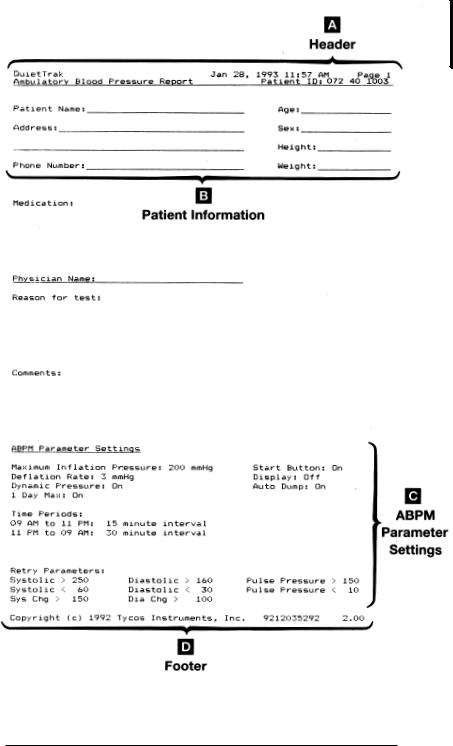
(Sample of ABPM Report, Page 1)
1-7

Ambulatory Blood Pressure Report —
The Data Summary
A Summary contains information about the Regular Run readings, including the time and date of the first and last attempted Regular Run readings.
Number of readings expected includes all programmed and manual readings.
Number of readings used is the number of accepted readings.
Minimum, Maximum, Average, Number of Systolic > 140 mmHg, Number of Diastolic Readings > 90: These are calculated from the accepted Regular Run readings.
B Hourly Averages are presented in a table that includes data from the Regular Run readings for each of the 24 one-hour intervals in a day. If ABP monitoring was conducted for more than a one-day period, then the hourly averages include the values obtained during that hour for all days of use.
The table contains these values:
Hour always begins on the hour (i.e., 07 AM) and ends after the last minute of the hour.
Num is the number of Regular Runs taken during each onehour period.
Sys is the average Systolic value for each hour.
Dia is the average Diastolic value for each hour.
HR is the average heart rate value for each hour.
The data is also represented graphically to the right of the data table. The average Systolic and Diastolic values are shown as “*”, and the average heart rate values are indicated with an “0”.
C Time Period Averages provide the calculated statistics from each ABP monitoring period.
1-8

(Sample of ABPM Report, Page 2)
1-9

Ambulatory Blood Pressure Report —
The Readings
In the final page or pages of the report, results from each reading are listed separately. The length of the final report section varies with the total number of readings that were taken. (The example shown here was shortened so that each part can be explained on one page.)
Readings Included in Averages. The data from each reading are provided, including the day ( ), time ( ), Systolic and Diastolic pressures ( ), heart rate ( ), and an initiation code ( ) designating which type of reading was taken.
The data are also presented graphically for convenient reference.
1-10
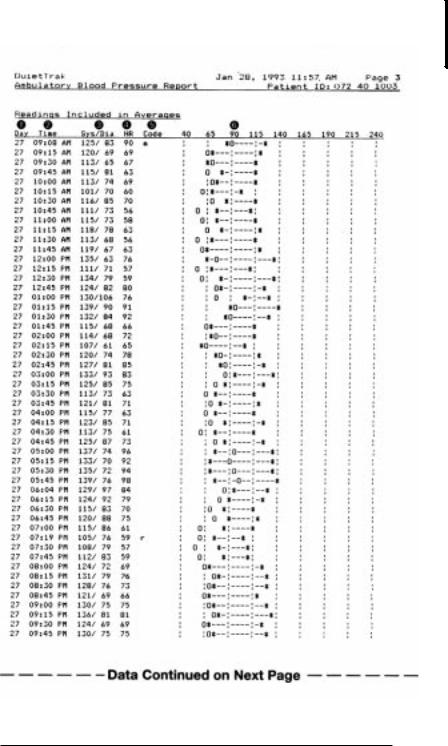
(Sample of ABPM Report, Page 3)
1-11

AInitiation Codes. Initiation code explanations are listed below the table of included readings.
BReadings Excluded from Averages. The data from any excluded readings are presented in this table with the error code or retry reason code.
CError Codes Error code explanations are listed below the table of excluded readings.
1-12
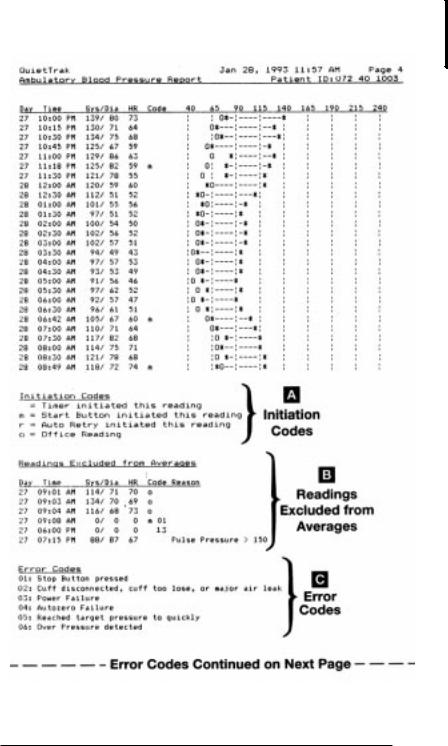
(Sample of ABPM Report, Page 4)
1-13

(Sample of ABPM Report, Page 5)
1-14

Getting Started |
2 |
|
This section identifies all of the product components included with the Tycos QuietTrak Ambulatory Blood Pressure Monitor. You will learn about the control keys of the ABP monitor and setup basics so that you can get started using the ABP monitor.
Page |
Topic |
2-2 |
Unpacking Checklist |
2-4 |
Features at a Glance |
2-7 |
Battery Requirements |
2-8 |
Loading the Batteries |
2-9 |
The Power-On Self-Test |
2-10 |
Setting Date & Time |
2-1
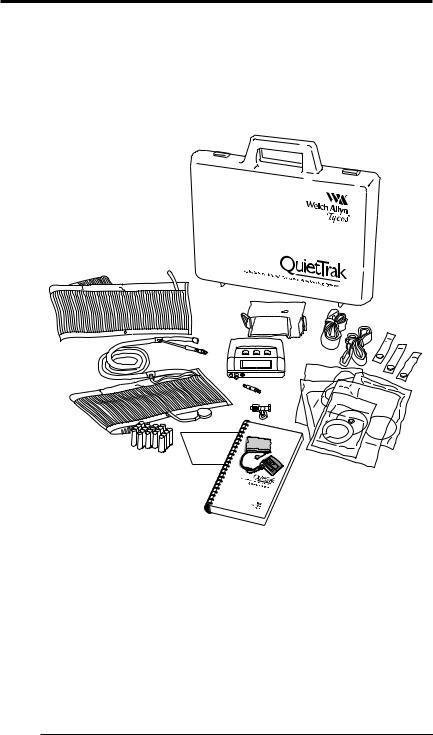
Unpacking Checklist
After you have unpacked the Tycos QuietTrak ABPM and the components, identify each item with the checklist that follows and inspect for missing items. Retain the shipping materials in case of shipping damage or for return, if necessary, to Welch Allyn/Tycos for repair or warranty service.
|
TAR |
|
H |
M |
|
RIG |
|
|
LEFT ARM
31.5
cm
M
AX
SIZE
AR
TERY
ARM
LEFT
IGHTARM
R
ARTERY
31.5
cm
MAX
SIZE
2-2

Content Checklist
ATycos QuietTrak ABPM: The Tycos QuietTrak ABPM is a compact, lightweight unit that is carried in a pouch and worn by the patient during the ABP monitoring period.
BOperator Manual: (This manual) Review and save this helpful product reference.
CABP monitor Pouch: The pouch covers the ABP monitor and adapts to either a belt, worn at the patient’s waist, or a shoulder strap.
DBelt and Shoulder Straps: (One each) Adjustable to a wide range of sizes.
EMedium Cuff with Bladder: (One each)
FLarge Cuff with Bladder: (One each)
GMicrophone and Pneumatic Assembly: (One each) Comes pre-connected to the Medium size cuff with bladder.
HBatteries: (Five sets) Four AAA batteries are required for each ABP monitoring procedure.
IHookup Kits: (Five each) Each kit includes Patient Diary, microphone anchoring pad, and cuff anchoring pad.
JCuff Anchoring Straps: (Three each) The straps stabilize the cuff during the ABP monitoring period.
KCalibration T-connector: (One each) Allows connection of Tycos QuietTrak ABPM to standard sphygmomanometer for calibration check and simultaneous arm measurement.
LInstrument Warranty Card: Fill this out today and return it to the Welch Allyn/Tycos Service Center. This card validates your warranty.
MQuietTrak ABPM Carrying Case: (One each)
Note: Report any signs of shipping damage to the carrier. If ! an item is missing or damaged, contact the Welch Allyn/
Tycos Service Center nearest you, or your distributor.
2-3
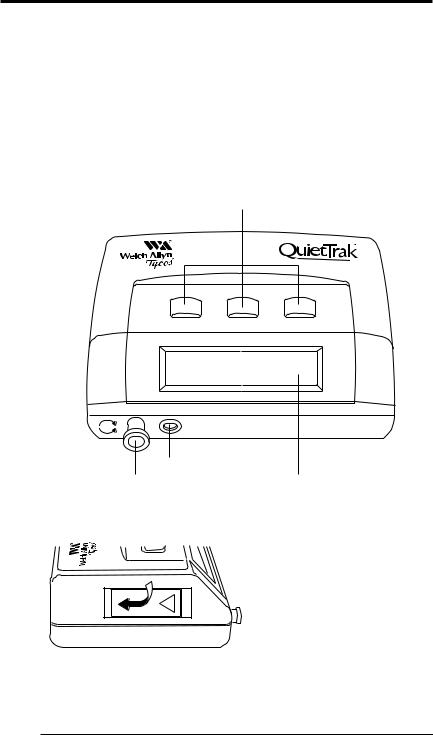
Features at a Glance
The uncomplicated design of the Tycos QuietTrak ABPM is one of its best features. There are only a few parts to learn.
ABP monitor Anatomy
Top/Front View of the Tycos ABP Monitor. The three control buttons, LCD (liquid crystal display), cuff hose connector, and the microphone connector are shown here.
Three Control Buttons
S Y S / D I A mmHg |
♥ |
Microphone Connector |
|
Cuff Hose Connector |
LCD Display |
Side View of the Tycos QuietTrak ABPM. To open the battery compartment, apply gentle pressure with your finger and slide the door in the direction of the arrow. The door will unlatch and open.
To close the door, first press the door closed while sliding it in the direction of the arrow. Once the door is flush with the ABP monitor, allow the door to spring back in the opposite direction to latch.
2-4
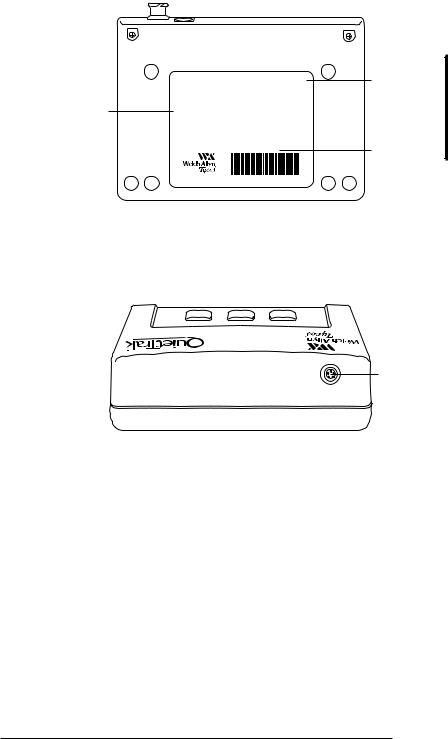
Setup
Instructions
QuietTrak™ |
Model No. 5100-01 |
Patient Setup Instructions
•Insert new AAA batteries prior to every setup.
•Carefully position and secure the microphone over the brachial artery, approximately 1 to 1.5 inches (2.5 to 3.8 cm) above the elbow. Position cuff with artery marker directly over microphone.
•Confirm proper setup by completing three office runs. •Program the unit for the regular run mode.
•Instruct the patient to remain as motionless as possible during readings.
•Instruct patient on the use of the diary and patient
activation button. |
9302255EF7 |
|
95 Old Shoals Road, Arden, NC 28704 USA |
45P3245E |
|
Model
Number
Serial
Number
Bottom View of the Tycos QuietTrak ABPM. The label on the bottom of the ABP monitor lists the model number, serial number and a summary of setup instructions.
Data Outpu
Connector
Back View of the Tycos QuietTrak ABPM. The connector on the back of the ABP monitor is for data output to a printer or an optional PC interface.
Turning the ABP Monitor’s Power On or Off
There is no On/Off switch to operate. The ABP monitor is On when batteries are loaded and Off when the batteries are removed.
2-5

Description of Control Buttons
The Tycos QuietTrak ABPM has only three buttons, but with them, the operator can:
•Set the date and time
•Enter patient data
•Choose programming features
•Retrieve the ABP monitoring data.
What each button does depends on the command or choice that is shown on the display screen beneath it.
|
|
|
Three-Button Control. You will |
|
|
|
press a button to respond to a |
Yes |
No |
Next |
message on the display screen. |
|
|||
Do Office Run 1 ? |
The Display Screen. The bottom |
||
|
|
|
line of the display screen provides |
a question or message, while the top line of the display offers choices. The buttons correspond with the choices.
2-6

Battery Requirements
!
!
Replace Batteries for Every Patient Study.
Install four new AAA alkaline batteries prior to each patient hookup. Fresh batteries provide the power to inflate the arm cuff 100-300 times during a oneor multi-day period. For maximum ABP monitoring periods, fresh batteries are required.
If the ABP monitor reaches a low battery state, it automatically discontinues the measurement cycle to reserve the power it will later need to transfer the data. Partially-used batteries shorten the ABP monitoring session. Therefore, attempting an ABP monitoring session with used batteries is not recommended.
Data Storage Protection: An internal battery of the Tycos QuietTrak ABPM powers the data’s memory storage and protects the data even if the AAA batteries wear down. Data is preserved even during battery replacement.
Concerning the Use of Rechargeable Batteries:
Rechargeable NiCad batteries can be used in place of alkaline batteries. With fully-charged NiCad batteries, 100 measurement cycles are achievable with average case usage (Medium size cuff and 180 mmHg average inflation level). The length of the ABP monitoring session could vary with different cuff sizes or with batteries which are not fully charged.
Remove the Batteries to Store the ABP monitor.
At the conclusion of an ABPM procedure, we recommend that you print the report and remove the used batteries from the unit. This will eliminate the risk of attempting a new patient study with used batteries. If you want to wait to print the report at a later time, go ahead and remove the batteries; the internal lithium battery will retain all patient data until you retrieve it or intentionally erase the data.
Internal Battery
An internal lithium battery powers the time, date, parameters, and data retention for at least five years. The internal battery ensures that the ABP monitor won’t lose data when you remove or replace the AAA batteries.
When the internal battery needs replacement, return the ABP monitor to the nearest Welch Allyn/Tycos Service Center.
2-7
